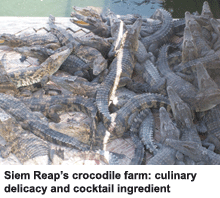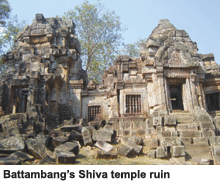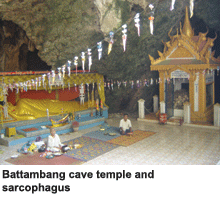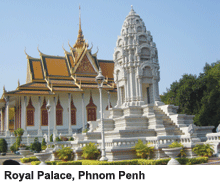Although some corners of Cambodia are untouched by the excesses of mass tourism, it’s quite clear that this country is being influenced by neighbouring Thailand. Massage parlours, western-style bars and discos have mushroomed in every little town. Yoginder Sikand continues his exploration of Cambodia
 Naturally Angkor Wat, the largest religious structure in the world, was the high point of my visit to Cambodia recently. But there’s more to this little country than the ruins of Angkor in the north west upon which French naturalist Henre Mouhat stumbled, half-subm-erged in a jungle in the mid 19th century.
Naturally Angkor Wat, the largest religious structure in the world, was the high point of my visit to Cambodia recently. But there’s more to this little country than the ruins of Angkor in the north west upon which French naturalist Henre Mouhat stumbled, half-subm-erged in a jungle in the mid 19th century.
Although some corners of Cambodia are untouched by the excesses of mass tourism, it’s quite clear that this country (pop: 14 million) is being influenced by neighbouring Thailand. Massage parlours, Western-style bars and discos have mushroomed in every little town and taxi drivers are quick to offer call-girls and even child prostitutes. Heroin, hashish and marijuana — mostly home-grown, are rampant and easily available. Swarms of sex tourists drift around languidly and stay on for months leading lotus-eating lives.
Having ensconsed myself in a cosy home-stay in Siem Reap — the base point for visitors to the Angkor National Park — for a paltry US$7 (Rs.315 per night), I was tempted to stay on for a few days after completing the mandatory temple circuit. Siem Reap is calm and unhurried, and its few sights are all accessible on foot.
One of the highlights is the sprawling crocodile farm, where these long-snouted, saber-toothed reptiles laze in the tropical sun, piled on top of each other like bizarre trapeze artists, sniping inter se often leaving gaping, bloody wounds of which they are supremely unmindful. Yet this farm isn’t a centre for the protection of this endangered species.
Crocodile meat is a rare culinary delicacy in Cambodia (aka Kampuchea) and is supplied from here to up-market restaurants catering to western visitors on the look-out for the exotic. The farm’s shop also sells crocodile blood in little glass phials. According to local connoisseurs, crocodile blood and rice wine make an excellent cocktail with aphrodisiac properties. These unfor-tunate amphibians also serve other commercial purposes — the heads of baby crocodiles are turned into key chains, their paws into pen heads, and their rough, wrinkled skins into wallets and belts.
In the heart of Siem Reap there’s also a delightful souvenirs market, where the true flavour of Cambodian urban and rural life can be experienced. Cambodian handicrafts are wonderful works of art, and the astonishing variety of stuff on sale at the market is incredibly cheap — copper Buddhist and Hindu icons; water-colour paintings splashed on handmade rice paper depicting Angkor temples and rustic scenes; wooden masks; puppets; exquisite silver daggers and bowls, and intricately woven silk sarongs. Fortune tellers sporting lampshade hats sit alongside ancient rustics with more than a touch of the exotic, vending bottled snakes and scorpions.
Next door, women offer fish massage, which requires you to insert your feet into knee-high aquariums for them to be tickled by swarms of tiny fish greedily attacking the dead skin on your heels and toes. These local, small-time entrepreneurs — most of them women — do brisk business, exuding warmth and good cheer without overcharging foreigners. Remarkably, even desperately poor Cambodians including landmine victims, refrain from begging; they sell loops of noodles, handmade candles or dried fish lollipops.
 After a four-day sojourn in Siem Reap I headed south-east to the town of Battambang, a three-hour journey to the west. The bus trundled across flat plains cut into squares of parrot-green paddy fields lined with towering palms and wooden stilt houses. Each habitation has its own wat or Buddhist temple, and all of them feature an outer wall crowded with mythical winged and fanged beasts, pierced with an ornate entrance atop which sits a serene Buddha, his eyes closed to the clutter around him. Invariably a red-tiled multi-roofed building, with gable edges and fire spouting dragons on the eaves, occupies the centre of the complex.
After a four-day sojourn in Siem Reap I headed south-east to the town of Battambang, a three-hour journey to the west. The bus trundled across flat plains cut into squares of parrot-green paddy fields lined with towering palms and wooden stilt houses. Each habitation has its own wat or Buddhist temple, and all of them feature an outer wall crowded with mythical winged and fanged beasts, pierced with an ornate entrance atop which sits a serene Buddha, his eyes closed to the clutter around him. Invariably a red-tiled multi-roofed building, with gable edges and fire spouting dragons on the eaves, occupies the centre of the complex.
My guidebook had promised that Battambang was off the tourist trail, which made it attractive. I checked into the friendly Holiday Guest House, patronised mainly by visiting Chinese merchants, and settled into a spacious, sparkling clean room priced at US$ 4.95 (Rs.223) per day. The guest house skirted a wide, leafy road lined by colonial-style bungalows dating back to the French occupation which ended in the mid-1950s. My room opened onto the gently flowing Stung Sanker river, on which boats moved imperceptibly, children leapt from giant boulders into the muddy waters, and sagacious ancients crouched on the banks patiently waiting for fish to bite.
I spent four leisurely days in and around Battambang (pop.250,000), Cambodia’s largest civic settlement after Phnom Penh, the capital. One day, I climbed into a toy-like van and headed for a forgotten Hindu temple 15 km from Battambang. The quaint vehicle raced through thick banana and papaya plantations and teak and toddy forests, with wooden bridges curling over narrow bamboo-fringed streams. We stopped at a traditional food factory, where peasant women offered dried mollusks on flat bamboo plates, while wielding oar-shaped ladles to stir wasps and cockroaches in lakes of sugar syrup drowned in pot-bellied vats, while simultaneously pounding fish-flavoured cheese in enormous cauldrons boiling on log fires. Exotic fare, but less than appetising for this vegetarian traveller.
The temple — dedicated to Shiva — has long fallen into disuse. It stands on a rocky knoll, overrun by giant roots of thick-leaved trees which climb out of invisible crannies in its walls. It must have once been a massive structure but now all what remains is a crumbling skeleton, with its carved stone pillars scattered about untidily. It dramatically symbolises the eclipse of Hinduism in this remote corner of South-east Asia.
The triumph of Buddhism in Cambodia is signified by the gargantuan, and evidently new wat a hundred metres away, its walls richly decorated with kitsch paintings depicting the many personae of the Buddha. Behind it, sited around a lily pond, is the monastery, comprising a series of thatched bamboo huts for monks and nuns. The low drone of cheerful novices with shaven heads clad in ochre robes emanates from a hall. Older monks are at work, tending plants or heaping sheaves of rice straw to reinforce their roofs. Another line of monks, all barefoot, wind their way out of the monastery, their heads bowed, each carrying an enamel bowl tucked under their robes. They were heading to the nearby settlement to collect their day’s offering from pious village folk.
 The manager of the guest house recommended a visit to Wat Banan, 20 km south of Battambang. Having already visited two dozen or more wats in the week past, I was hesitant at first. But it wasn’t a grand temple crowded with gilded Buddha statues that greeted me. It was an ancient Hindu-Buddhist ruin, set in the midst of a vast, dry plain ringed with low hills. The shrine was perched atop a hill accessible by conquering 360 steps each almost 2 ft high. The wooden banisters were in the form of hydra-headed serpents. I was close to fainting when I finally managed to haul myself up to the summit, where, passing through a narrow stone gateway, I emerged into a clearing ringed by five Shiva temples, modestly-sized and intricately carved with a profusion of petals, buds and demi-gods. Tall, fluted cone-shaped towers tapered above their bases, but their inner recesses were dark and bare: the original idols had long since been looted, their sites taken up by brand new, factory-made plaster-of-Paris Buddhas, at the feet of which lay plates filled with rice balls, cheroots and half-filled glasses of wine — animistic offerings to spirits.
The manager of the guest house recommended a visit to Wat Banan, 20 km south of Battambang. Having already visited two dozen or more wats in the week past, I was hesitant at first. But it wasn’t a grand temple crowded with gilded Buddha statues that greeted me. It was an ancient Hindu-Buddhist ruin, set in the midst of a vast, dry plain ringed with low hills. The shrine was perched atop a hill accessible by conquering 360 steps each almost 2 ft high. The wooden banisters were in the form of hydra-headed serpents. I was close to fainting when I finally managed to haul myself up to the summit, where, passing through a narrow stone gateway, I emerged into a clearing ringed by five Shiva temples, modestly-sized and intricately carved with a profusion of petals, buds and demi-gods. Tall, fluted cone-shaped towers tapered above their bases, but their inner recesses were dark and bare: the original idols had long since been looted, their sites taken up by brand new, factory-made plaster-of-Paris Buddhas, at the feet of which lay plates filled with rice balls, cheroots and half-filled glasses of wine — animistic offerings to spirits.
A half-hour drive took me to the limestone hills of Phnom Sampheau, where, winding through dense forest, I arrived at a row of caves. The first was a giant, gaping canyon, more than 150 ft deep, fringed with trailing stalactites not unlike demon fangs. Here, drunken or spaced out soldiers of the Khmer Rouge, the maniacal regime that ruled and ruined Cambodia in the mid-1970s, had hurled almost 10,000 people, mostly teachers, monks, doctors, lawyers and political activists — anyone who could possibly challenge their brutal rule — to their death. These intellectuals — the flower of the nation — were first used as slave labour, made to level entire mountains and build dams with bare hands, until they lost all capacity for work. Then they were given their quietus in this and several other caves within the surrounding mountains.
Inside the first cave it was dark, cold and eerie. But, as my eyes got used to the darkness, I recoiled in horror upon finding myself in a gruesome sarcophagus of the dead. A giant cage with a pagoda-shaped dome loomed before me, and through the wire mesh I saw hundreds of human skulls of the Khmer Rouge’s forgotten victims, ruthlessly piled atop each other. A little boy sat at the foot of the cage rattling a tin, soliciting alms. A wrinkled woman, dressed in widow white, sat beside a giant reclining Buddha that stretched along the inner wall of the cave. This had been her home for the past 20 years, I was told. She had a beatific smile as she sat at the Buddha’s feet, gently caressing them. Her family had been wiped out by the Khmer Rouge, in this very cave. She beckoned me, tied a red thread on my wrist and waved her hand around my head in blessing.
 It was time to leave Cambodia. I boarded a bus heading for Phnom Penh, Cambodia’s bustling, nerve-wracking capital, an eight hour drive to the south-west from where I was to emplane for Bangkok. I hurriedly visited the modest monuments that Phnom Penh boasts — the Royal Palace, a collection of grand colonial-style mansions stuffed with gold and silver thrones and beds, mandatory wats, and gilded Buddha images decked with emeralds and diamonds the size of pigeon eggs. I mused at how the Buddha would have reacted since the majority of Cambodians continue to scratch out miserable lives below the poverty line.
It was time to leave Cambodia. I boarded a bus heading for Phnom Penh, Cambodia’s bustling, nerve-wracking capital, an eight hour drive to the south-west from where I was to emplane for Bangkok. I hurriedly visited the modest monuments that Phnom Penh boasts — the Royal Palace, a collection of grand colonial-style mansions stuffed with gold and silver thrones and beds, mandatory wats, and gilded Buddha images decked with emeralds and diamonds the size of pigeon eggs. I mused at how the Buddha would have reacted since the majority of Cambodians continue to scratch out miserable lives below the poverty line.
My last night in Cambodia was spent in a wat in a run-down part of the town, a fitting conclusion to my fortnight’s visit to this most intriguing country I have explored. A procession of women, poor for the most part, as evidenced by the way they were dressed, filed into the central hall, bearing pale-hued lotus buds and slim incense sticks. In the background, a young lad struck a massive gong to a slow, haunting beat.
The women silently took their places in the hall, bowing every once in a while to the rows of doe-eyed monks who sat on the other side of the aisle murmuring prayers. Incense wafted gently through the hall and then, at the sound of a bell, the entire congregation burst into soft, rhythmic chanting. I recognised the words, for they were in Pali — the Buddhist statement of faith and surrender: I take refuge in the Buddha; I take refuge in the Sangha; I take refuge in the Dhamma.